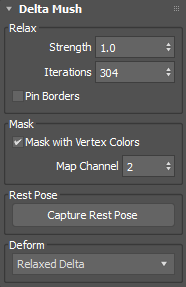Smooths the mesh while retaining detail based on a relaxed default pose.
Use the Delta Mush operator to filter deformation artifacts and create smoothing effects. The Delta Mush operator provides vertex data
 .
.
Delta Mush Parameters rollout

Use Legacy Compute
The legacy (pre v. 2023 Update 2) Delta Mush deformer caused problems with the processing of symmetrical meshes. It has since been improved.
Turn this option on to use the legacy Delta Mush computation method. This option is also activated when you load older scene files to make sure that they behave the same way as before. However, for new scenes, this box is unchecked and the new process is used; there is no need to use legacy computation.
You can switch between the legacy and new, improved compute, however, be sure to do this when the geometry is at the "neutral" or "rest" pose, as the rest pose stores information critical to Delta Mush functionality. A warning message displays to alert you when this occurs.
Relax group
- Strength
- Controls how far vertices move during each smoothing operation.
- Iterations
- Sets how many times to repeat the smoothing process.
- Pin Borders toggle
- When enabled, pins boundary vertices to their current position so they do not move during smoothing. This option is particularly useful when working with multiple objects, or multiple elements within a single object, that share open edges.
Mask group
- Mask with Vertex Colors toggle
- Masks off areas of an object using a vertex color.
- This setting is useful for controlling the strength of the Delta Mush, specifically to preserve detail on smaller features.
- Map Channel
- Sets the map channel assigned to the selected vertex color.
Rest Pose group
- Capture Rest Pose button
- Sets a default, neutral pose for the purposes of calculating smoothing operations.
Deform group
- Deform menu
- Specifies the current deformation: either Relaxed Base Mesh, Relaxed, or Relaxed Delta.
